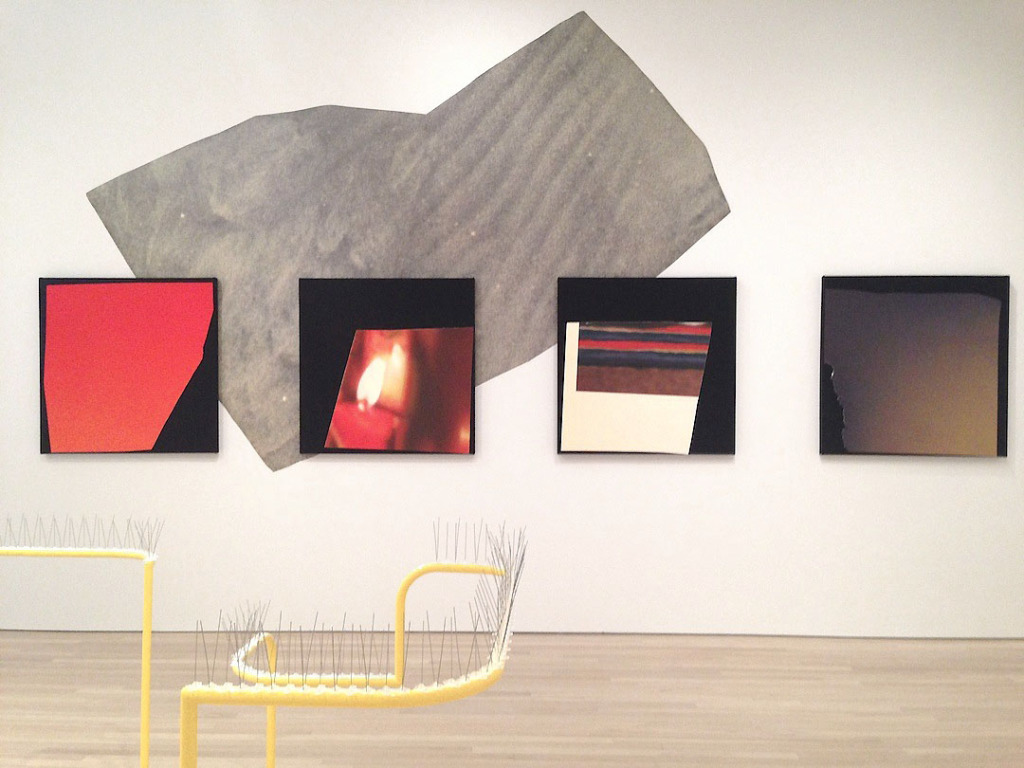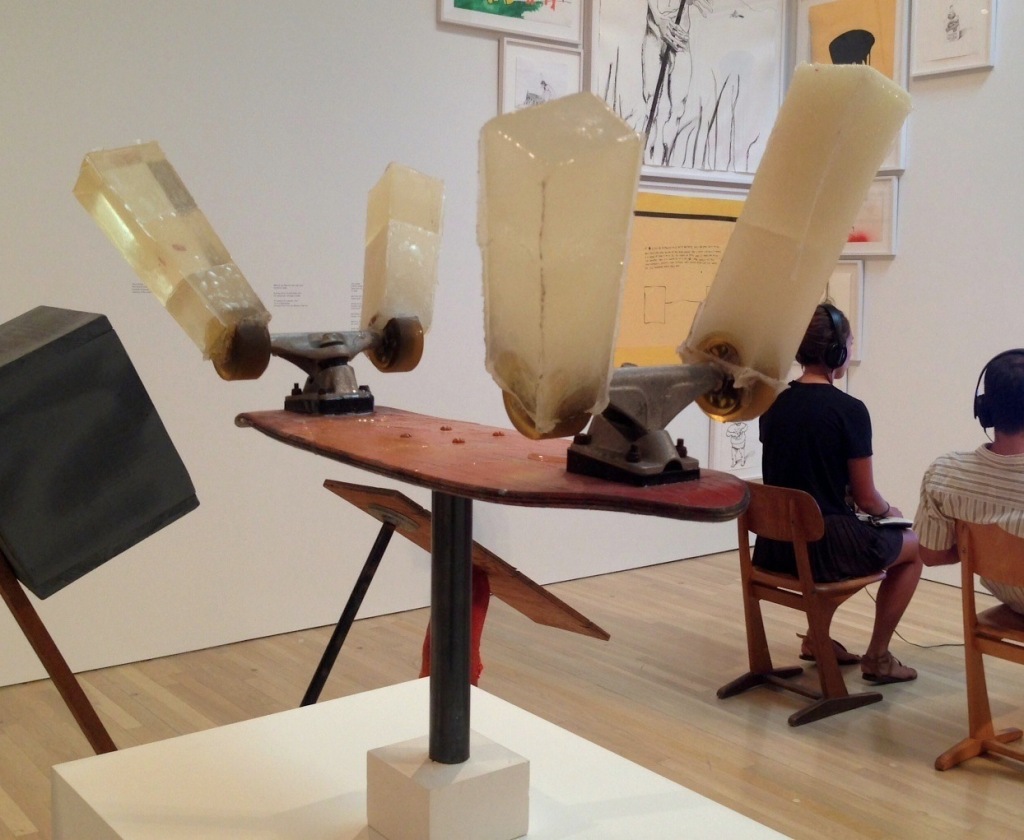![photo 2[2]](https://eyes-towards-the-dove.com/wp-content/uploads/2014/09/photo-221-1024x768.jpg)
Piero Golia, Installation view, construction of ‘George Washington’s nose from Mt. Rushmore’, Made in L.A., 2014, Hammer Museum, California
The curators, Connie Butler and Michael Ned Holte, did a great job at directly participating in an active conversation about contemporary art. Not only did they participate but they contributed to the discussion. When dealing with the geographic East Coast versus West Coast and the American market within the global market it is possible to identify that cultural particulars have become less dominant and the result is an expansion allowing for deeper human understanding. One might say that the state of contemporary art, in an anti-pragmatic manner, has returned to a humanistic moment, guttural even. Made in L.A. features works by artists who have explored the world through their own processes. Emily Mast, in ENDE (Like a New Beginning), 2014, uses the body in physical space, designed and choreographed —in as much as you can curate and activate breath—captured in HD video format and live performances that occurred throughout the duration of the exhibition.
Installed on the Lindbrook Terrace, Gabriel Kuri had a series of sculptures (untitled cig butts /carrara white HM03, 2014) made of creamy white marble. Formally abstract yet also familiar in a very simplistic way, the weighted forms channeled antiquity with a twist. Angular and blocky, a frontal seam or crevice present in each sculptural form, holds a crumpled, yellowed, extinguished (i.e. smoked) cigarette. They are so clean and simple, merging a historical association that we have with marble immediately brought to the present and demystified by stamping out the cigarette. Functioning as a contemporary relic, this gesture made the work relevant today. Kuri, born 1970 in Mexico City, succeeds in creating both reaction, disregard and appreciation, all in a very brief moment. Almost all of the work in Made in L.A. followed this format, communicating, not necessarily in a new language or with new words, but rather with new arrangements that allowed for the continuation of an ongoing discourse rather than that of a closed-door or formal punctuation mark at the end of a sentence.
This form of artistic approach also rang true for Piero Golia (b. 1974, Naples, Italy) and a sculpture that was in progress for the duration of the exhibition. A replica of George Washington’s nose appropriated from Mt. Rushmore was also installed on the Linbrook Terrace. Golia, with assistants, worked on his sculpture in-situ. Large chunks of white styrofoam surrounded the smoother form, like floating, jagged icebergs. Similar to Kuri’s monuments, this piece speaks directly to time, performance, production, ownership and identity. On a head that stands 60 feet tall, who owns the nose of George Washington (1732–1799) as sculpted in the stone façade of Mount Rushmore? [Side note: The issue of land ownership where Mount Rushmore was carved is still ongoing as the land was claimed and taken from the Lakota Tribe in 1876.] Mount Rushmore is a feat, which came to fruition over the course of nearly twenty years by Gutzon Borglum and his son Lincoln Borglum, Danish-Americans. It has since stood for the nationalism of America by way of our politicians and the hegemony of a patriarchal society. The appropriation of the nose, an appendage as a free-standing object, amputated and reinterpreted in a lighter, whimsical material, can be appreciated simply or read as a physical inquiry into the comprehension of a shape, a beacon and a nation.
Made in L.A. functioned as a complex sentence offering an acute survey on artists who, like those in New York or London, are in a metropolis. Beyond installations by Harry Dodge (Supernumerary Phantom Limbs and the Comedy of Reciprocal Interference, 2012) and Mariah Garnett (Full Burn, 2014, focusing on the lives of recent U.S. war veterans who often migrate to L.A. to become stunt doubles in Hollywood films) much of the work felt less concerned with being made in Los Angeles, than it did with a deeper, spot on, spatial exploration of the human condition as seen through a West Coast lens.

Background: Kim Fisher, Installation view, Made in L.A. (Work courtesy of China Art Objects Gallery
Foreground, Gabriel Kuri, Sculpture detail, 2014, Made in L.A., Hammer Museum, California
![photo 2[5]](https://eyes-towards-the-dove.com/wp-content/uploads/2014/09/photo-25-1024x746.jpg)
Background: Kim Fisher, Installation view, Made in L.A. (Work courtesy of China Art Objects Gallery Foreground, Gabriel Kuri, Sculpture detail, 2014, Made in L.A., Hammer Museum, California
![photo 3[3]](https://eyes-towards-the-dove.com/wp-content/uploads/2014/09/photo-33-1024x833.jpg)
Danielle Dean, Training, 2014, Two-channel video, color, sound, 11:16 min., Made in L.A., Hammer Museum, California
![photo 3[5]](https://eyes-towards-the-dove.com/wp-content/uploads/2014/09/photo-35-1024x768.jpg)
Mariah Garnett, Full Burn, 2014, Video, color, sound, 20:00 min. Courtesy of the artist and ltd los angeles, Made in L.A., California
![photo 3[6]](https://eyes-towards-the-dove.com/wp-content/uploads/2014/09/photo-36-1024x768.jpg)
Foreground: Magdalena Suarez Frimkess and Michael Frimkess, Installation view individual clay pot sculptures from a 50 year body of work, Made in L.A., California Background: Caitlin Lonegan, Untitled, 2013, Oil, metallic oil, and iridescent oil paint on canvas, Made in L.A., Painting part of the permanent collection of the Hammer Museum, California

Harry Dodge, Detail, Supernumerary Phantom Limbs and the Comedy of Reciprocal Interference, 2012, Skateboard, urethane resin, steel pipe, galvanized flange, screws, and Hydrocal. Courtesy of the artist and Wallspace, NY. Install view from Made in L.A., Hammer Museum, California, 2014
All photographs taken with iPhone 5c by Katy Diamond Hamer.
When visiting L.A. be sure to stay in the super stylish Ace Hotel Downtown, for a taste of Brooklyn without the risk of inclement weather. Their in-house restaurant L.A. Chapter is a sibling to Five Leaves and Nights And Weekends in Williamsburg. The team, Jud Mongell and Ken Addington never disappoint and whether stopping by for Sunday brunch or weekday dinner, the menu offers everything from a classic burger to locally sourced seafood dishes. Yum.
Made in L.A. was on view at the Hammer Museum from June 15th through September 7th, 2014.
More soon!
xo
